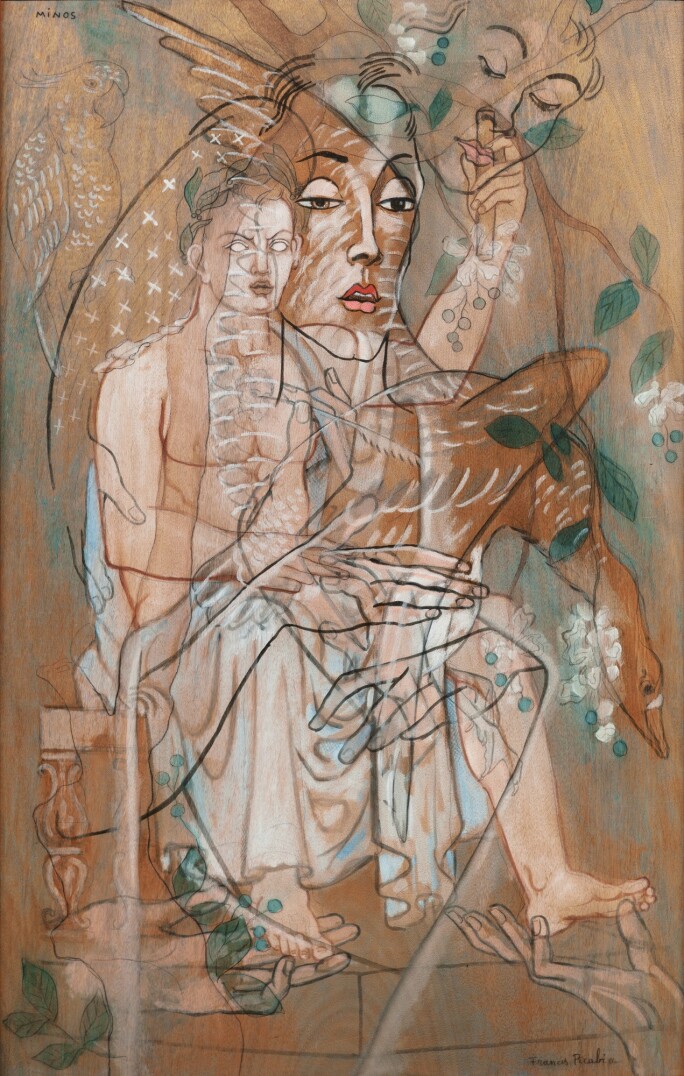“They are about freedom of line and color and blur the distinction between drawing and painting. They are about improvisation on the human figure and its consciousness.”
Presenting a mesmerizing landscape of architectural figuration and compelling materiality, Transparent Figures wholly embodies the irrefutable beauty, conceptual gravitas, and unparalleled technical finesse which characterize the very best of George Condo’s celebrated oeuvre. Executed in 2016, the present work stands at the apex of the artist’s continued series of Drawing Paintings, which deftly synergize the traditionally separate processes of drawing and painting in single, fluid gestural expression. In their celebratory fusion of captivating imagery and spontaneous mark-making, the alluring beings of these paintings blur the boundary between figurative and non-representational painting with graceful ease. Even within this celebrated group, Transparent Figures is exemplary exhibiting a richly sensual surface of lush impasto in nuanced, jewel-like hues. In this luminous work, executed in grand scale, Condo fuses the tactile with the visual, the figurative with the fragmented, and the known with the imaginary to produce an irresistible final image. Underscoring its significance, the present work was notably chosen for recent major exhibition George Condo: The Way I Think, organized by The Phillips Collection in Washington, D.C. and the Louisiana Museum of Modern Art in Humlebæk. A masterpiece in the artist’s signature mode, Transparent Figures revels in the unforeseen beauty and alluring, hedonistic entropy of Condo’s improvisational genius.

Right: ROBERT RYMAN, UNTITLED, 1962-1963. PRIVATE COLLECTION. Art © 2020 Robert Ryman / Artists Rights Society (ARS), New York
Charged with emotional intensity and psychological depth, Transparent Figures features a crowd of faint yet striking figures interwoven together in a kaleidoscopic composition. Within a Cubist topography, sensuous lines and lush passages of flat color overlap into a densely layered web of unrestrained abstraction, infused with a sense of rhythm and polyphony that stems from Condo’s spontaneous, gestural improvisations. Throughout the work, bodies are fragmented into disjointed planes of color along the same innovative vein as Marcel Duchamp’s Nude Descending a Staircase, No. 2 and Pablo Picasso’s Les Demoiselles d’Avignon. Within Condo’s creative output, the genre of portraiture occupies a position of tremendous importance. Taking inspiration from masters as varied as Diego Velázquez, Edouard Manet, Giorgio de Chirico, Pablo Picasso, Willem de Kooning and Philip Guston, Condo weaves into the fabric of figurative painting a renewed interest in inserting art historical tropes into a playful and absurd new context, both reviving and humorously undermining the integrity of the genre of portraiture. For Condo, it is the imaginary potential of portraits that defines the genre for him; as such, the artist tends to paint from his own mental snapshot or emotional reaction, rather than from life. The artist’s frenzied brushwork is anchored by sharp, fragmented lines evoking an enormous range of human emotions that collide into a riot of forms that bridge the gap between an emotional state and an imagined physical reality.


Condo’s Transparent Figures from 2016 pushes the boundaries on his ever-evolving exploration of the human form and his unique ability to push the sculptural, three-dimensional form within the confines of a two dimensional canvas. Condo ruptures his compositions to reveal the multifaceted complexities of human emotion through his aptly self-termed mode of psychological cubism. “I try to depict a character’s train of thoughts simultaneously – hysteria, joy, sadness, desperation,” the artist explains. “If you could see these things at once that would be like what I’m trying to make you see in my art.” (The artist in Stuart Jeffries, “George Condo: ‘I Was Delirious. Nearly Died’,” The Guardian, 10 February 2014, online) Condo has established himself in the canon of Western art history as a master puppeteer of the human psyche, presenting to his audience forms that delight and repulse, amuse and sadden, welcome and alienate. Transparent Figures captures the best of Condo’s unraveling and subsequent reassembly of various pictorial languages, which has cemented him as one of today’s most clever and cutting-edge contemporary painters.

